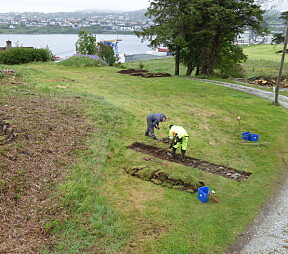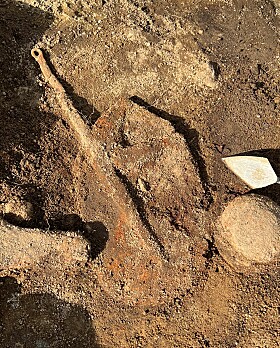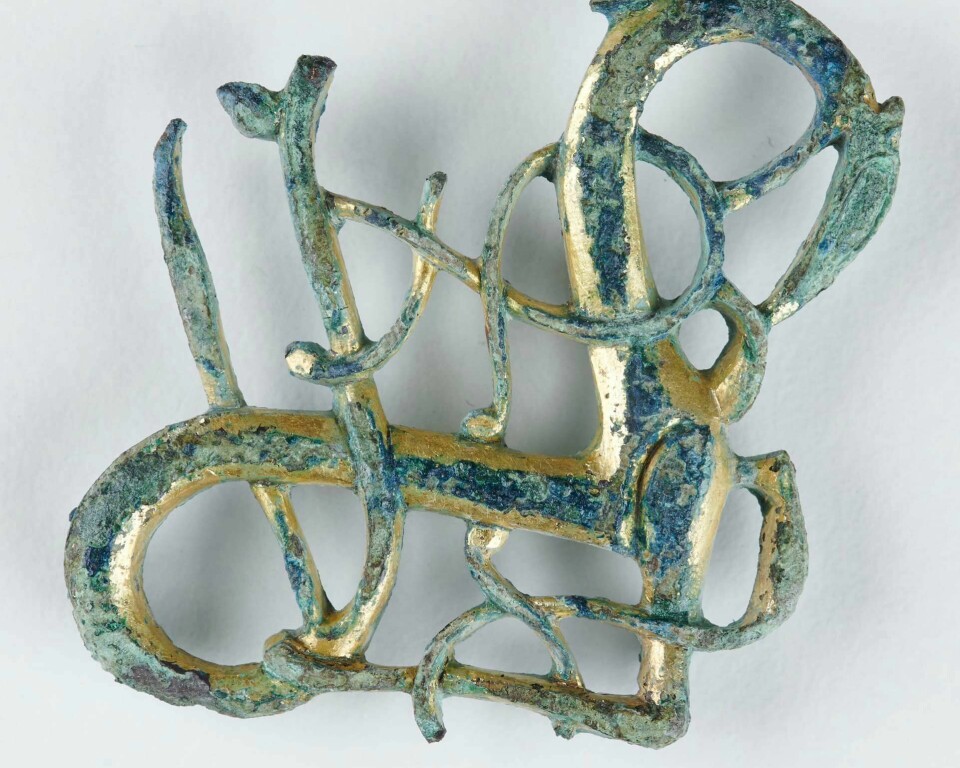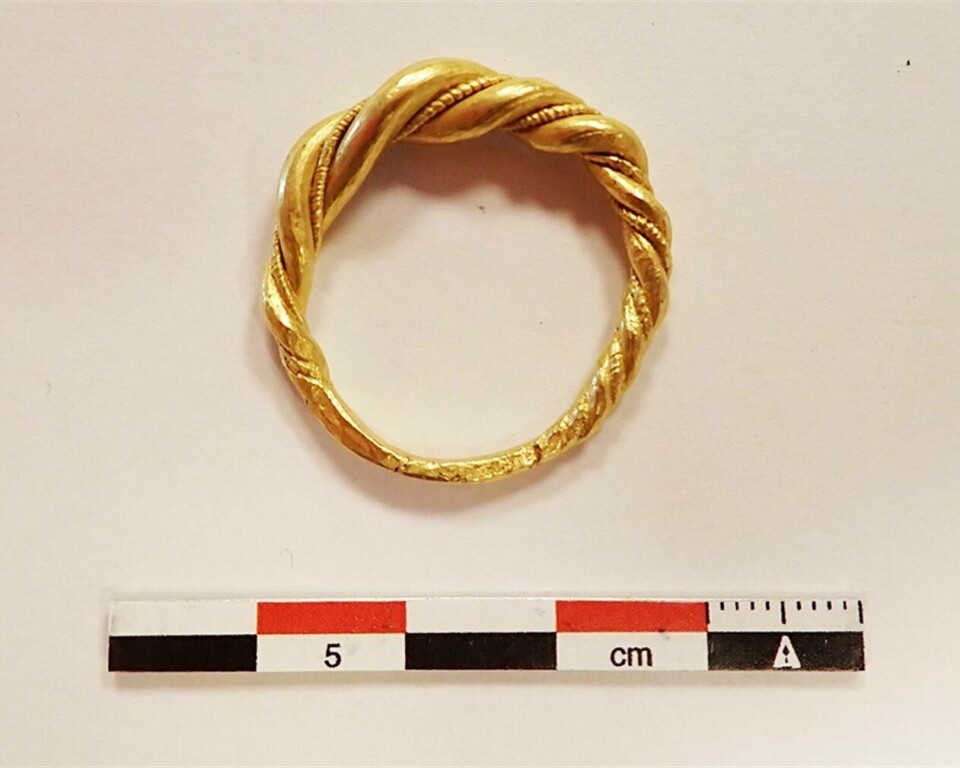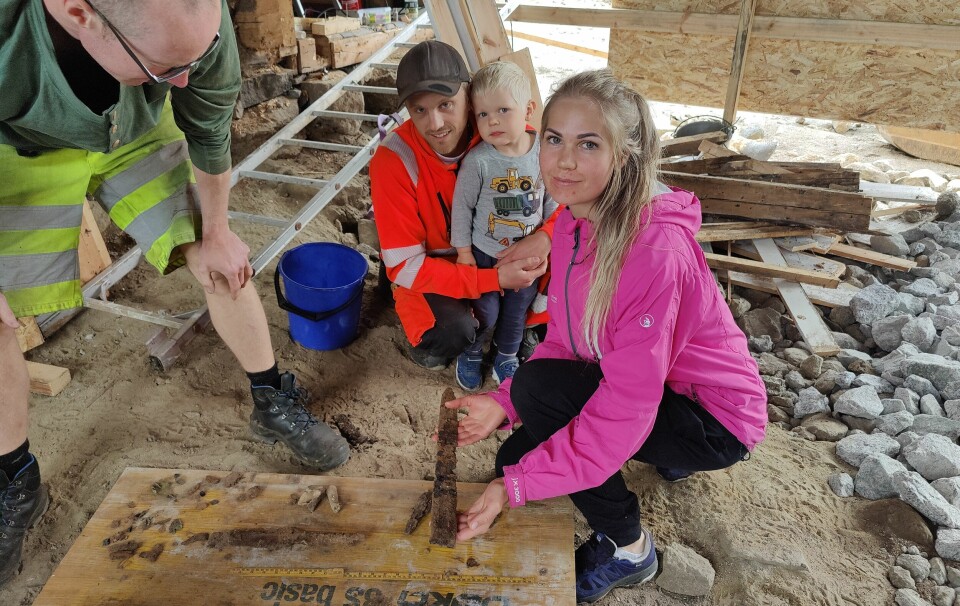
The couple were just extending their house: Found a grave from the Viking Age in their garden
That thing sticking up from the earth, which looked a bit like the blade of a sword, turned out to be exactly that. From the Viking Age.
Oddbjørn Holum Heiland was spending his Friday night getting started with the digging behind the Setesdalshouse from 1740 that he and his wife Anne are planning to extend out back.
“I wasn’t going to dig a lot, just a little bit in the slope behind the house, to get some more space between the house and the land,” Heiland says to sciencenorway.no on the phone from Setesdal in Southern Norway.
When he removed the grass and the top soil, he found an oblong stone. He didn’t think much of it, put it aside, and kept digging.
When the digging bucket dug into the next layer, the moraine under the top soil, an iron thing all of a sudden popped up.
“I looked at it and thought that this looks a loot like a sword blade. And then when I released the contents of the digging bucket, the hilt of the sword fell out.”
Oddbjørn realized that the stone he had just removed might be a gravestone. He googled a bit, and found an almost identical sword from the Viking Age which was found in another part of the country some time ago.
“That’s when I realized that this must be some Viking stuff,” he says.
And then Oddbjørn did exactly what the archaeologists want people in such situations to do. He stopped digging, put the items he had dug out in a safe place, and come Monday morning, he called the county municipality.
Already the day after that call, county archaeologist Joakim Wintervoll in Agder county municipality and Jo-Simon Frøshaug Stokke from the Museum of Cultural History in Oslo came to see the find.
And surely enough, they could confirm: A Viking was once laid to rest here.
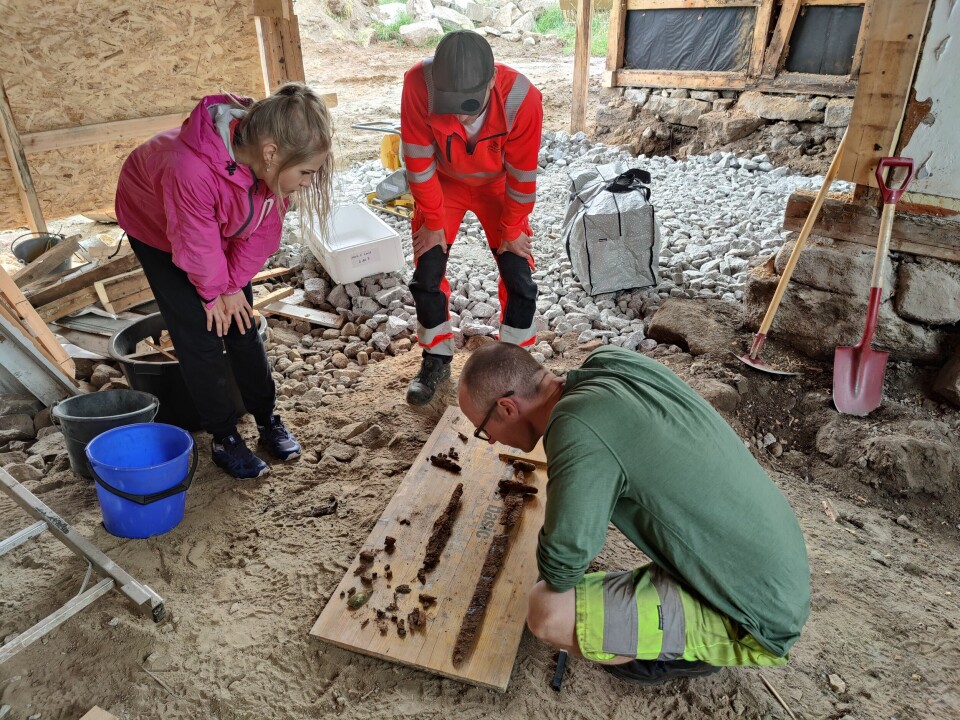
Sword fashion from the Viking Age
It’s not exactly your everyday happening to be called regarding finds of possible swords from the Viking Age.
“I immediately cleared my schedule and made some calls to see what was possible to get done,” Joakim Wintervoll says to sciencenorway.no.
“Jo-Simon and I went up there together to have a look at it, and it was quite clear that this was a grave. It is a very rare find, very exciting,”
It’s the make of the sword that allows the archaeologists to date the find. The two pieces of the sword that were found make out a 70 cm long sword, and the blade is 5 cm at the broadest point.
“But it’s the hilt that tells us this is a sword from the Viking Age,” Wintervoll explains.
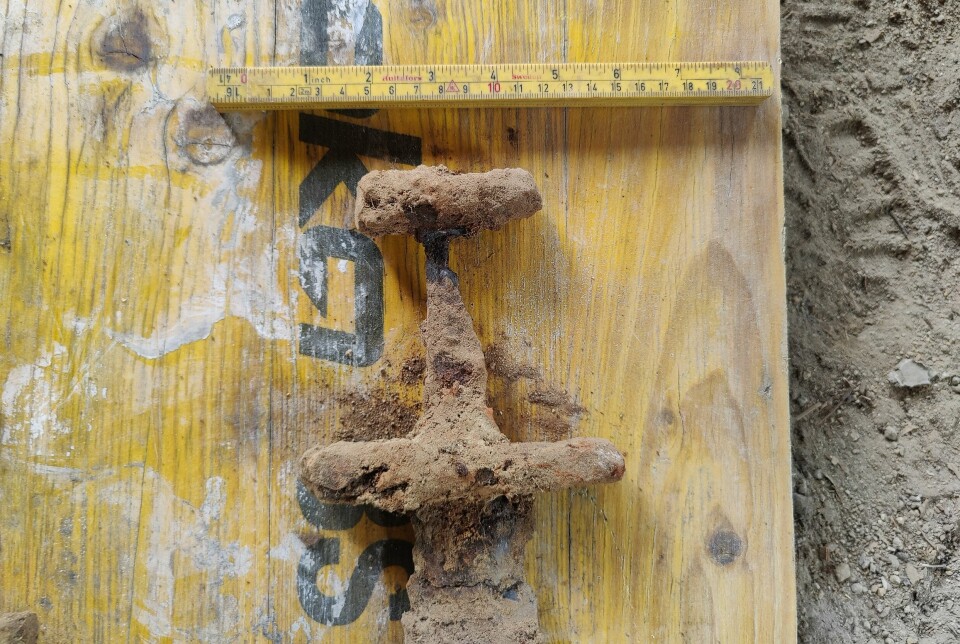
The hilt of a sword is an object of fashion, and the style of the hilt found in Setesdal places it at around the end of the 800s and the beginning of 900.
“We have datings for different styles of hilts from year zero, so we have a pretty good overview of how these hilts have changed from the early Iron Age and into the Middle Ages,” Wintervoll says.
The Holum Heilands had applied for approval of their extension. They live, after all, in an old house from 1740.
“We didn’t think it was likely that anything would be found there,” Wintervoll says.
“It’s a pretty far way from other cultural heritage sites.”
And besides, Anne’s parents had dug around the house before, in the 1970s. It seems a complete coincidence that the spot where the grave is has not been touched until now.
“We are very grateful that they stopped digging and contacted us straight away,” county archaeologist Wintervoll says.
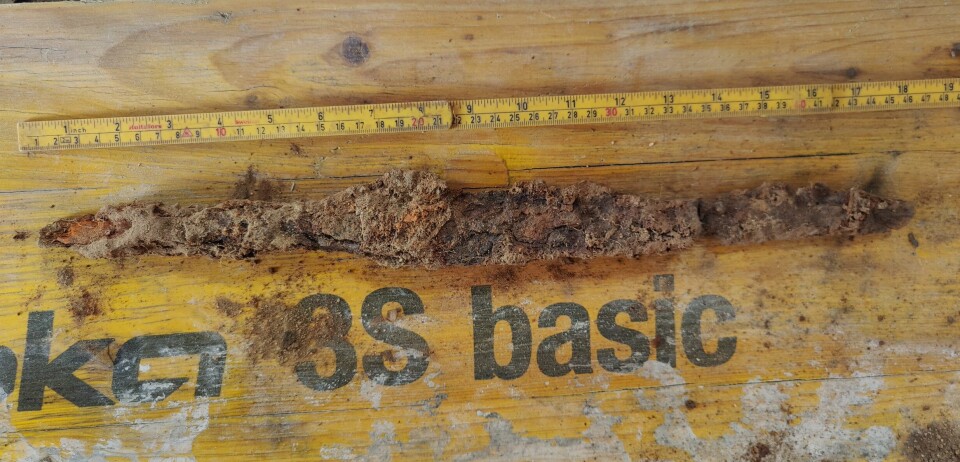
Weapons and gilded jewellery
The grave in Setesdal didn’t just contain a sword and a possible gravestone. A lance, a long spear designed to be used on horseback, had also been placed in this grave. So far however, no other traces suggest that this is the grave of a mounted warrior.
Glass beads gilded with gold and a belt buckle were also found.
“When we were about to put the buckle in the box that goes to the museum, we saw a glimmer of gold in the surface, so we believe that perhaps also the buckle was gilded with gold,” Wintervoll says.
And finally, a brooch had also been laid down in the grave, the sort that could be used to keep a cape in place. It is made of bronze and had a typical Viking animal motif.
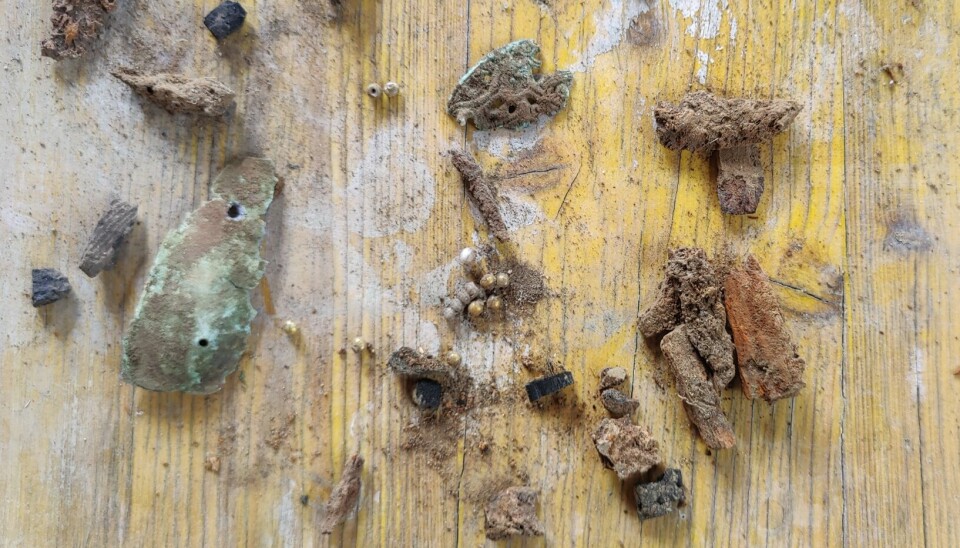
A particularly rich weapon grave
“It’s very rare to discover weapon graves from the Viking Age, and this grave is a little richer than we are used to. The objects are also a bit better preserved than what we normally have to work with,” says Jo-Simon Frøshaug Stokke, the archaeologist at the Museum of Cultural History in Oslo who accompanied Wintervoll in examining the find.
“Usually, we find one or two objects, not like here where there is a set of weapons with both a sword and a lance, and then also jewellery,” he says.
Though rare, the find is not unique.
“This is a set of weapons that we know well from other Viking Age graves. And Setesdal is an area where we have also previously found this type of weapon grave,” Stokke explains.
Fancy Vikings
Whoever was buried here once upon a time was from the higher echelons of society.
“Even if we often imagine Vikings with helmets and swords, very few Vikings could actually afford this,” Stokke says.
Most of the Vikings that went on raids brought farmers weapons with them, such as axes and spears. In this grave, somebody has been buried with both a sword and a lance.
“These weapons alone make this a rich grave, but then you have the jewellery as well. So this is a person who clearly had some resources,” Stokke says.
And the jewellery could no doubt have belonged to a man.
“When we see weapons we think man, and when we see jewellery we think woman. But this is a very modern divide,” the archaeologist says.
“The Vikings liked to wear jewellery. It's not at all unique to find jewellery in a man’s grave, these were fancy people. And then there is the discussion on whether women carried weapons, and there are some indications of that as well.”
RELATED: Was there such a thing as a female Viking warrior?

Visible graves claim ownership
The grave might not have been very big. Perhaps it was just a pit in the ground, which was then covered by a stone. That the grave was placed exactly in this spot is not a coincidence.
“Burying is done by the descendants of those who have died. They are claiming the land where the person lies,” Stokke explains.
There used to be a collection of smaller farms just 100-150 metres away from where the grave is located. It is reasonable to assume that these farms existed back at that time, or perhaps even further back in time, according to the archaeologist.
“A pattern that we see is that you bury those who have owned land near the farm, and often in a spot that is easily visible from the nearby roads. People who passed by would then see the grave and know that the people who live here have ancestors who have lived here for a long time. These are our relatives; we lay claim to this land and have done so for generations. This is the function of the visible grave,” Stokke says.
The Setesdal-grave bears no traces of a mound, but the oblong stone that Oddbjørn Holum Heiland found was most likely a gravestone. It has either been laid flat on top of the grave or been placed in upright position.
And there it has lain, for a little more than a thousand years. Until a Friday night about a week ago.
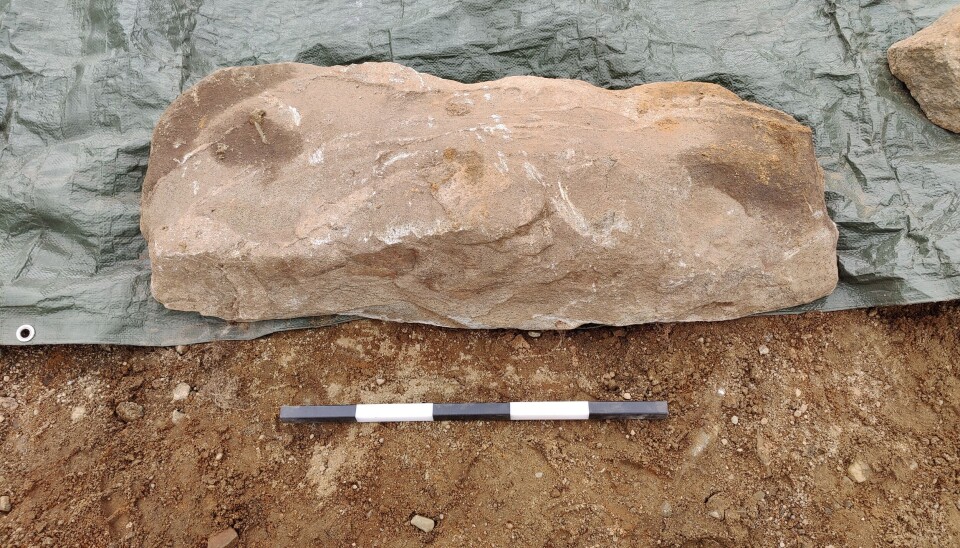
More digging in the week to come
The Museum of Cultural History have decided to excavate the site further next week.
In the little that is left, however, the archaeologists do not expect to find a lot.
“Perhaps we can find a bone, which would allow us to say something about the gender and age of the person buried here,” Stokke says.
This depends on whether the person was cremated or not.
“In any case, most of the organic material such as bones is most likely gone, but we always hope we might find something small,” he says.
Back in Setesdal, Oddbjørn Holum Heiland is excited to see whether the archaeologists will find anything else in the grave.
He was a little sceptical, before he contacted the county municipality.
“I wondered whether this would mean a complete stop of all our building plans. But it’s really not been a problem, they’ve been very easy to deal with,” he says.
The message he’s been given is that this won’t take too long.
“And in any case, a bit of a delay is no disaster, I’ve got plenty of stuff that needs doing,” Holum Heiland says.
“And it is after all a very special thing. We have a Viking grave right behind our house.”
———
Read the Norwegian version of this article on forskning.no
------








